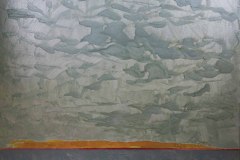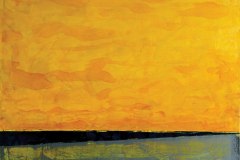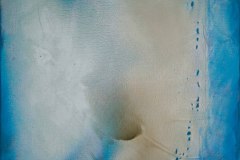“You make one pour, and that drives the whole painting,” Naples Art District artist Richard Diedrich says, gesturing toward one of his paintings laying on a table. His careful manipulation of poured paint mimics the flow of water and how it coalesces. Richard’s highly abstracted paintings are ephemeral and often moody in color. Their translucent veils are interspersed with rivulets of texture—a far cry from the tight renderings Richard Diedrich created during his previous career as a lauded Atlanta architect and instructor at Harvard University Graduate School of Design.
Richard Diedrich started painting as a graduate student at the University of Illinois Urbana-Champaign. “The architecture school is within the school of fine arts,” he says. “So, we had five years of art with studying architecture. We had a watercolor professor just for the architects. I’d render all my projects in my career in watercolor.” After 34 years in the field, he sold his architecture firm in 2002 and returned to painting, focusing on the landscape surrounding his home on North Georgia’s Lake Burton. “I really liked the idea of what happened on the edge of the water,” he says. “You had this architectural necklace of the cottages and boathouses where the water meets the land.”
At first, he used watercolor to depict the lake and shoreline realistically. The more he painted, the more he removed visual details, like buildings and the surrounding mountains, until only water remained. He called the series Man on the Edge, speaking to humanity’s tendency to settle where the water meets the land. “If you’ve seen satellite photographs of the Earth at night, they dramatically show civilization along the edges of continents,” he says. “I’ve always loved those photographs because it makes that propensity so imminent.”
Richard Diedrich lays his canvases flat and fluidly disperses paint across the surface to mimic water washing over land. Similar to how he’d adjust the pitch of a roof on a building, he gently tilts the primed canvas so the watercolors and water-based inks stream and ripple, often creating minuscule bodies of water all their own. He’ll then spray the canvas with water or blow across the wet paint, moving the pigments like wind shifting the tides. The finished paintings appear veil-like and pristine, while the edges reveal layers of thick, iridescent ink over watercolor, each vibrant drip soaking the canvas.
Richard moved to Naples in 2015, after visiting for architectural projects over the years, including designing clubhouses at The Club at Mediterra and Grey Oaks Country Club. He found himself captivated by the surrounding waterways. “It goes back to water being a source of travel,” he says. “Before the Tamiami Trail, the only way you could get to Naples was on the water.” To showcase his love for the region, Richard published his fifth book this year, Painting Naples Architecture, which documents significant historic, midcentury and contemporary homes in his dreamy realist watercolor style. The artist is represented locally at Joel Shapses Studio and recently worked with interior designer Judith Liegeois to create works on a larger scale—stretching as tall and wide as 6 feet—for her Naples gallery and showrooms.
Richard’s fascinated by the movement and effects of water on land, at sea and in the skies. His diptych Nature Benign, Nature Unleashed captures two extremes in Southwest Florida. In Nature Benign, washes of paint depict a calm horizon pierced by radiant sunlight—its palette pastoral and Bahamian. On the other hand, Nature Unleashed is dominated by a hulking, surging silver mass that recalls the region’s summer thunderheads. The physical action undertaken in each painting—the thinness of the pours and subtle tilting of the canvas in Benign versus the thickness of the paint and more aggressive manipulation of its movement in Unleashed—effectively contrasts the waterscapes’ stillness and voracity.
Richard’s paintings range in perspective. In some, viewers could be lying at the bottom of a lake, looking up at its murky surface, while others recall the pulled-back views of aerial maps. The former architect uses straight edges (tools used to draw blueprints in the days predating computer software) to create faint lines running through his pours. “They signify latitude, longitude and that man had to navigate the water,” he says. The viewer could alternatively be looking out toward a horizon, distant and bright enough to distill the water and its adjoining land into chromatic, textural strips. It’s this last point of view that Richard considers most crucial. “The medium is the message,” he says. “It’s really true in my case.”
Pictured above:
Richard Dietrich’s Red Horizon (2019), 36×36 inches, mixed media on canvas. Photographed by Louis Venne.
Gold Sky, Wedge Shore (2020), 36×36 inches, mixed media on canvas. Photographed by Louis Venne.
Richard Diedrich’s After Georgia (2020), 20×20 inches, mixed media on canvas. Photographed by Louis Venne.








